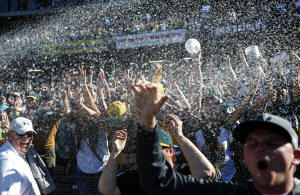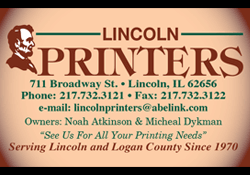As an era ends, the city that was
home to the Oakland A's comes to grips with their departure
 Send a link to a friend
Send a link to a friend
 [September 25, 2024]
By MICHAEL LIEDTKE [September 25, 2024]
By MICHAEL LIEDTKE
OAKLAND, Calif. (AP) — The Athletics had long ago carved out a
Jekyll-and-Hyde legacy as one of Major League Baseball's most
successful — and sad-sack — franchises. Under their belts: nine
World Series titles and 19 seasons of futility punctuated by 100 or
more losses.
This, though, is different. Now, legions of A's fans view the team
as the sport's most treacherous under the ownership of billionaire
John Fisher, an heir of the family that founded The Gap in 1969 —
one year after the A's moved to Oakland from Kansas City.
Just a few years after embracing “Rooted In Oakland” as their motto,
the A’s this week are coming to the end of their 57 see-sawing
seasons in a city regularly overshadowed by the mystique of its
storied neighbor, San Francisco.
“I know these times coming to the games are always going to be among
the best years of my life," longtime A's fan Will MacNeil, 40, rued
as he contemplated an ending that is crushing a community's soul.
“And for a billionaire owner to rip it away from me, it's
frustrating.”
A baseball team that has moved twice moves again
The A's exodus from Oakland will give the team the dubious
distinction of being the first Major League Baseball franchise to
have moved on four different occasions. After starting in
Philadelphia in 1901, the A’s moved to Kansas City in 1955, then to
Oakland in 1968, with California's capital city of Sacramento and
Las Vegas next in the peripatetic pipeline.
No place has been the A's home for as long as Oakland, where they're
the last professional sports team in a two-county region known as
the East Bay — home to 2.8 million people living across the water
from San Francisco.

Through the years, the baseball team became an emblem of East Bay's
grit and flair. The A's glory years included the colorfully attired,
mustachioed “Swingin' A's” during the first half of the 1970s, the
muscular and swaggering “Bash Brothers” of the late 1980s, and the
scrappy underdogs of the 2000s that yielded a real-life fairy tale
in the film, “Moneyball,” based on the Michael Lewis book that
ushered in the era of data-driven analysis.
Through those decades, the A's stadium — the now-crumbling Oakland
Coliseum — became an East Bay hub where people of all races, ages,
incomes and backgrounds rallied around a common cause.
“It was really like the public square," lifelong A's fan Jim
Zelinski said earlier this year. His father brought him to the
team's first game at the Oakland Coliseum on April 17, 1968 — a 4-1
loss to the Baltimore Orioles before a crowd of 50,164.
"I remember my dad telling me how sports can bring everybody
together, creating a sense of pride and identity,” he said.
Rooting for the A's connected everyone from longshore workers at
Oakland's bustling port to the tech geeks of Silicon Valley to
hippies from nearby Berkeley to technology to subversives forged in
the cauldron of a city where Huey Newton started the Black Panthers
and Sonny Barger led a notorious chapter of the Hells Angels.
“The A’s are such an indelible part of this community,” Zelinski
said. “Everybody was so proud of not only the teams, but there was
also this sense of, ‘Hey, this is us! This is the East Bay!’”
A storied ballpark is left behind
The Coliseum, lovingly known as baseball's “Last Dive Bar" after a
2019 story in The New York Times drew that analogy, is a remnant of
the 1960s when cities built stadiums designed to be used for both
baseball and football. Its deteriorating condition is why Fisher
began looking to build a new stadium for the A's soon after he
bought the team for $180 million in 2006.
For all the derision aimed at the facility, the Coliseum has been
the site for three of the 24 perfect games thrown in baseball
history, and it's the place where Rickey Henderson set the record
for career stolen bases. It also has been the been the backdrop for
the four World Series championships the A's won in Oakland; only the
Yankees, with seven championships, have won more since 1968. Seven
winners of the American League's Most Valuable Player award have
starred for the Oakland A's, as have five pitchers who won the
league's Cy Young award.
Three of the A's World Series title were won in consecutive years
under the ownership of Charles O. “Charlie” Finley, who brought the
team to Oakland from Missouri.
Finley brought his mule “Charlie O” with him to serve as the team
mascot and made an unsuccessful push to get the leagues to use
orange baseballs and allow designated runners. But before selling
the A's in 1980, Finley also pushed for night games during the World
Series so more people could watch the games on TV and the designated
hitter rule so fans wouldn't have to watch pitchers try to hit. The
former is a staple today, as is the later — though purists still
debate it.
[to top of second column] |

Oakland Athletics fans celebrate after the Athletics defeated the
Minnesota Twins in a baseball game to become American League West
champions, Sept. 22, 2013, in Oakland, Calif. (AP Photo/Beck
Diefenbach, File)

Finley died in 1996, long before the 50-year
reunion of the 1974 World Series champions held in June. But his
niece, Nancy Finley, flew in from Texas to represent the family
during the ceremony at the Coliseum, where she worked for much of
the 1970s. It will likely be her last visit; she can't bear the
thought of attending the A's final game in Oakland on Thursday.
“I wouldn't want to be there. It would be too hard,” Nancy Finley
said. “I can't stop having flashbacks whenever I go back there. I
have every section, row and seat memorized.”
The bond between fans and a community is strong
Other beloved sports teams have spurned their devoted fans by moving
elsewhere through the decades, including the baseball's Brooklyn
Dodgers and New York Giants in 1958 and the National Football
League's Colts, whose moving vans left Baltimore for Indianapolis in
1984 during the middle of the night.
But none of them have been jilted in quite the same way as the East
Bay.
“It’s taken so long for this move to evolve that it’s been like a
slow death eating me up very single day,” said A’s fan Mike Silva,
72, wiping away tears as he showed some of his old ticket stubs.
“You can still cheer for them after the move, but you are just gong
to be cheering for the uniform,” he said. “It’s not the same. ”
The NFL's Raiders already turned their back on Oakland twice. They
did it first in 1982 when they moved to Los Angeles before coming
back in 1995, only to leave for Las Vegas in 2020 — the year after
the National Basketball Association's Warriors hopped over the bay
to San Francisco.
After the A's decided to follow the Raiders to Las Vegas, Fisher
poured more salt into Oakland fans' wounds. Rather than stay in the
Coliseum, Fisher chose to move the A's 85 miles northeast to a
minor-league ballpark in Sacramento for at least the next three
years while waiting for the new stadium in Nevada to be built.
Hundreds of A's employees and Coliseum concession workers, including
some who had been there for more than 40 years, will be laid off
when the A's leave Oakland behind.
On Monday, after staying fairly mum during the final season, Fisher
wrote an open letter to fans and the community. His words echoed
with regret.
“The A’s are part of the fabric of Oakland and the East Bay and the
entire Bay Area,” Fisher wrote. “I know there is great
disappointment, even bitterness. ... I can tell you this from my
heart: we tried. Staying in Oakland was our goal. It was our
mission, and we failed to achieve it. And for that I am genuinely
sorry.”
Some are coming out to the bitter end
Many devout A's fans have been boycotting games in disgust. Those
who still come, like Will MacNeil, regularly lead chants of “Sell
the team!'" before lobbing a profanity at Fisher.

MacNeil, known as “Right-Field Will” after being a fixture in the
Coliseum's bleachers for nearly 20 years, has accumulated about 200
A's jerseys during his fandom. He estimates only 20 fit him now
because of the weight he put on while drowning his sorrow about the
team's move in beers.
"I know I shouldn’t have been because it’s only sports, but this
move really destroyed me,” MacNeil said as he cheered the A's on to
a victory in May.
Zelinski, the fan who attended the A's first game in 1968, spent
nearly 30 years fighting to keep sports teams in Oakland. When the
season started, he still didn't want to believe it would all be to
no avail.
“I had some of the greatest memories of my life at the Oakland
Coliseum,” Zelinski, 65, said in April. “The A's are such an
irreplaceable part of the East Bay culture that I don't think people
can quite grasp what incredible sadness there is going to be like at
that final game in September."
He will never find out. After a long battle with bladder cancer, Jim
Zelinski died June 7 — the same day that A's outfielder JJ Bleday
slugged a homer in the bottom of the ninth to catapult the team to a
2-1 victory.
Here in Oakland, as a quiet end approaches, that sets us up to leave
you with an observation that the former baseball commissioner, A.
Bartlett Giamatti, once made about the sport. It hangs over the
community this week like a misplaced curveball: “It breaks your
heart. It is designed to break your heart.”
All contents © copyright 2024 Associated Press. All rights reserved |